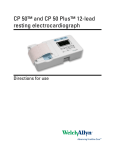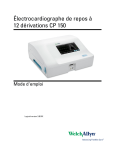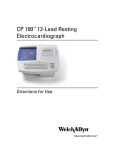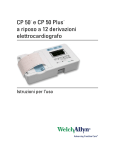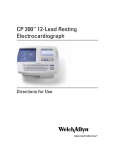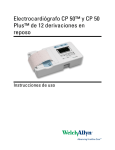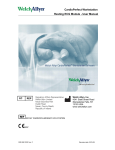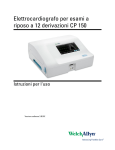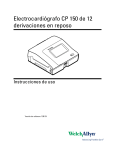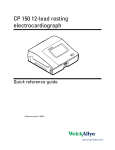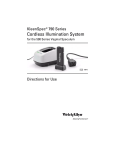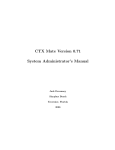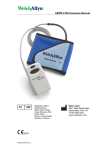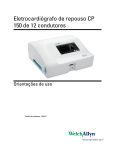Download CP 50 User Manual
Transcript
™ ™ CP 50 and CP 50 Plus 12-lead resting electrocardiograph Directions for use ii Welch Allyn CP 50 resting electrocardiograph © 2009 Welch Allyn, Inc. All rights are reserved. No one is permitted to reproduce or duplicate, in any form, this manual or any part thereof without permission from Welch Allyn. Caution: Federal US law restricts sale of the device identified in this manual to, or on the order of, a licensed physician. Welch Allyn assumes no responsibility for any injury, or for any illegal or improper use of the product, that may result from failure to use this product in accordance with the instructions, cautions, warnings, or indications for use published in this manual. Welch Allyn is a registered trademark of Welch Allyn, Inc. CP 50, CP 50 Plus, and CardioPerfect are trademarks of Welch Allyn, Inc. PDI and Sani-Cloth are registered trademarks of PDI, Inc. CaviWipes is a trademark of Metrex Research Corporation. Software in this product is copyright Welch Allyn or its vendors. All rights are reserved. The software is protected by United States of America copyright laws and international treaty provisions applicable worldwide. Under such laws, the licensee is entitled to use the copy of the software incorporated within this instrument as intended in the operation of the product in which it is embedded. The software may not be copied, decompiled, reverse-engineered, disassembled or otherwise reduced to human-perceivable form. This is not a sale of the software or any copy of the software; all right, title and ownership of the software remains with Welch Allyn or its vendors. Welch Allyn Technical Support European Customer Care + 35 3 46 906 7790 Germany + 49 6950 985 132 Latin America (Miami office) + 1 305 669 9003 China + 86 21 6327 9631 Netherlands + 31 202 061 360 Malaysia + 60 3 7875 3341 Sweden + 46 858 536 551 United Kingdom +44 20 7365 6780 Australia + 61 2 9638 3000 Multilanguage CD: This manual: France + 33 155 69 58 49 102731 80015344, B Welch Allyn Ltd Navan Business Park Dublin Road, Navan County Meath, Republic of Ireland www.welchallyn.com iii Contents 1 - Introduction . . . . . . . . . . . . . . . . . . . . . . . . . . . . . . . . . . . . . . . . . . . . . 1 About this document . . . . . . . . . . . . . . . . . . . . . . . . . . . . . . . . . . . . . . . . . . . . . . 1 Intended use. . . . . . . . . . . . . . . . . . . . . . . . . . . . . . . . . . . . . . . . . . . . . . . . . . . . . 1 Indications for use . . . . . . . . . . . . . . . . . . . . . . . . . . . . . . . . . . . . . . . . . . . . . . . . 1 About the test types. . . . . . . . . . . . . . . . . . . . . . . . . . . . . . . . . . . . . . . . . . . . . . . 2 Features . . . . . . . . . . . . . . . . . . . . . . . . . . . . . . . . . . . . . . . . . . . . . . . . . . . . . . . . 3 Controls, indicators, and connectors . . . . . . . . . . . . . . . . . . . . . . . . . . . . . . . . . . 4 Symbols . . . . . . . . . . . . . . . . . . . . . . . . . . . . . . . . . . . . . . . . . . . . . . . . . . . . . . . . 5 General warnings . . . . . . . . . . . . . . . . . . . . . . . . . . . . . . . . . . . . . . . . . . . . . . . . . 7 General cautions . . . . . . . . . . . . . . . . . . . . . . . . . . . . . . . . . . . . . . . . . . . . . . . . . . 9 2 - Setup . . . . . . . . . . . . . . . . . . . . . . . . . . . . . . . . . . . . . . . . . . . . . . . . . 11 Connecting the patient cable . . . . . . . . . . . . . . . . . . . . . . . . . . . . . . . . . . . . . . . Loading the thermal paper . . . . . . . . . . . . . . . . . . . . . . . . . . . . . . . . . . . . . . . . . Powering the electrocardiograph . . . . . . . . . . . . . . . . . . . . . . . . . . . . . . . . . . . . About the menu . . . . . . . . . . . . . . . . . . . . . . . . . . . . . . . . . . . . . . . . . . . . . . . . . Viewing or changing the settings . . . . . . . . . . . . . . . . . . . . . . . . . . . . . . . . . . . . Viewing the device information . . . . . . . . . . . . . . . . . . . . . . . . . . . . . . . . . . . . . Verifying proper operation. . . . . . . . . . . . . . . . . . . . . . . . . . . . . . . . . . . . . . . . . . Connecting to an external USB printer (optional, CP 50 Plus only). . . . . . . . . . . Connecting to a CardioPerfect workstation (optional, CP 50 Plus only) . . . . . . . . . . . . . . . . . . . . . . . . . . . . . . . . . . . . . . . . . 11 12 14 15 16 16 17 18 19 3 - ECG testing . . . . . . . . . . . . . . . . . . . . . . . . . . . . . . . . . . . . . . . . . . . . 21 Attaching the leads to the patient. . . . . . . . . . . . . . . . . . . . . . . . . . . . . . . . . . . . 21 Electrode locations . . . . . . . . . . . . . . . . . . . . . . . . . . . . . . . . . . . . . . . . . . . . . . . 23 Performing an ECG test . . . . . . . . . . . . . . . . . . . . . . . . . . . . . . . . . . . . . . . . . . . 24 4 - Administrative tasks . . . . . . . . . . . . . . . . . . . . . . . . . . . . . . . . . . . . . 27 Turning the security option on or off (CP 50 Plus only). . . . . . . . . . . . . . . . . . . . Managing the user list (CP 50 Plus only) . . . . . . . . . . . . . . . . . . . . . . . . . . . . . . Turning the audit trail on or off (CP 50 Plus only) . . . . . . . . . . . . . . . . . . . . . . . . Managing the worklist (CP 50 Plus only) . . . . . . . . . . . . . . . . . . . . . . . . . . . . . . Managing the test directory . . . . . . . . . . . . . . . . . . . . . . . . . . . . . . . . . . . . . . . . 27 28 28 29 29 5 - Maintenance . . . . . . . . . . . . . . . . . . . . . . . . . . . . . . . . . . . . . . . . . . . 31 Cleaning the equipment . . . . . . . . . . . . . . . . . . . . . . . . . . . . . . . . . . . . . . . . . . . Inspecting the equipment. . . . . . . . . . . . . . . . . . . . . . . . . . . . . . . . . . . . . . . . . . Testing the electrocardiograph . . . . . . . . . . . . . . . . . . . . . . . . . . . . . . . . . . . . . . Replacing the battery . . . . . . . . . . . . . . . . . . . . . . . . . . . . . . . . . . . . . . . . . . . . . Replacing the AC fuses. . . . . . . . . . . . . . . . . . . . . . . . . . . . . . . . . . . . . . . . . . . . Storing the equipment . . . . . . . . . . . . . . . . . . . . . . . . . . . . . . . . . . . . . . . . . . . . Discarding the equipment. . . . . . . . . . . . . . . . . . . . . . . . . . . . . . . . . . . . . . . . . . 31 32 32 33 34 34 34 6 - Troubleshooting . . . . . . . . . . . . . . . . . . . . . . . . . . . . . . . . . . . . . . . . 35 Limited warranty. . . . . . . . . . . . . . . . . . . . . . . . . . . . . . . . . . . . . . . . . . . . . . . . . 39 Service policy . . . . . . . . . . . . . . . . . . . . . . . . . . . . . . . . . . . . . . . . . . . . . . . . . . . 40 iv Contents Welch Allyn CP 50 resting electrocardiograph A - Specifications . . . . . . . . . . . . . . . . . . . . . . . . . . . . . . . . . . . . . . . . . . 41 B - EMC guidance and manufacturer’s declarations . . . . . . . . . . . . . . 43 1 1 Introduction About this document This document is written for clinical professionals with a working knowledge of medical procedures and terminology required for monitoring cardiac patients. Before using the electrocardiograph for clinical applications — or before setting up, configuring, troubleshooting, or servicing the electrocardiograph — you must read and understand this document and all other information that accompanies the electrocardiograph and related options or accessories. Intended use The Welch Allyn electrocardiography products (subject devices) are intended for use by trained operators in health facilities. The subject devices provide the following diagnostic functions: • Acquiring, viewing, storing, and printing ECG waveforms using ECG front-end modules (patient cables) and associated accessories that provide signal acquisition for up to twelve (12) leads of patient ECG waveforms through surface electrodes adhered to the body. • Using optional algorithms to generate measurements, data presentations, graphical presentations, and interpretative statements on an advisory basis. These are presented for review and interpretation by the clinician based upon knowledge of the patient, the result of physical examination, the ECG tracings, and other clinical findings. Indications for use The electrocardiograph is one of the tools that clinicians use to evaluate, diagnose, and monitor patient cardiac function. The 12-lead ECG interpretive algorithm provides a computer-generated analysis of potential patient cardiac abnormalities which must be confirmed by a physician with other relevant clinical information. 2 Introduction Welch Allyn CP 50 resting electrocardiograph About the test types Auto ECG A report typically showing a 10-second acquisition of 12 leads of ECG information combined with patient data, measurements, and optional interpretation. Auto ECGs can be saved to the electrocardiograph’s test directory or to a USB massstorage device. In CP 50 Plus models, auto ECGs can also be sent to a Welch Allyn CardioPerfect workstation. Stat ECG An auto ECG that starts instantly without waiting for you to enter patient data or adjust the waveforms. Rhythm ECG A continuous, real-time printout of rhythm strips with a user-defined lead configuration. Rhythm ECGs are printouts only. They cannot be saved. A H B C D E F G Auto ECG report example A: 3 rows, 4 columns. B: Patient data. C: ECG measurements. D: Automatic ECG interpretation (optional). E: Report status label. F: Rhythm leads. G: Gain, speed, AC filter, frequency range, date and time, software version, device ID, practice ID. H: Calibration pulse. Rhythm ECG report example Directions for use Introduction 3 Features Pacemaker detection The software detects the possible presence of a pacemaker. If you confirm that the patient has a pacemaker, the ECG report includes no interpretation, and it indicates that a pacemaker was detected. Automatic ECG interpretation (optional) The optional MEANS interpretation algorithm, developed by the University of Rotterdam in the Netherlands, provides automatic analysis of ECG tests. For more information, see the MEANS Physicians' Manual or the PEDMEANS Physicians’ Manual on the CD that came with your electrocardiograph. The MEANS algorithm is used for adult patients 18 years and older. The PEDMEANS algorithm is used for pediatric patients from 1 day through 17 years old. 4 Introduction Welch Allyn CP 50 resting electrocardiograph Controls, indicators, and connectors Power button AC power indicator Auto ECG button Rhythm ECG button Pressure point for closing the printer door Printer-door latch Equipotential terminal Ethernet connector (RJ45 for PC), functional on CP 50 Plus only Mini USB connector (for PC) USB connector (for mass-storage device, printer) AC power inlet AC fuses Patient-cable connector Mounting holes for the CP 50 mobile-stand adapter (optional) Battery door Directions for use Introduction Symbols Documentation symbols Warning (Warnings indicate conditions or practices that could lead to illness, injury, or death.) Caution (Cautions indicate conditions or practices that could damage the equipment or other property.) Consult operating instructions. Operation symbols Power on/standby Search Auto ECG Rhythm ECG Accept Close Previous Next Help Menu Backspace Power symbols (LED off) No AC power is present. Battery is absent or faulty. (LED green) AC power is present, and battery is fully charged. (LED amber) AC power is present, and battery is charging. Battery is charged to the indicated level. Alternating current Battery is charging. Dangerous voltage Battery door Fuse Rechargeable battery Protective earth Nonionizing electromagnetic radiation Equipotential terminal Lithium ion 5 6 Introduction Welch Allyn CP 50 resting electrocardiograph Connectivity symbols USB Ethernet (RJ45) Shipping, storing, and environment symbols +50°C This end up Keep dry. Fragile Relative humidity limit Atmospheric air-pressure limits Temperature limits 7 -20°C Separate the battery from other disposables for recycling. Recycle. Separate the device from other disposables for recycling. See www.welchallyn.com/weee. China RoHS (restriction of hazardous substances) symbols for control of pollution caused by electronic information products. 5-year environment-friendly use period (EFUP) for batteries. 10-year EFUP for the device. For details, see the accompanying documentation. Miscellaneous symbols Heartbeats per minute Hot surface. Do not touch. Manufacturer Date of manufacture Defibrillation-proof Type CF applied parts Defibrillation-proof Type BF applied parts Reorder number Serial number Do not reuse. Batch code Meets essential requirements of European Medical Device Directive 93/42/EEC. European community representative min Software activation code Directions for use Introduction 7 General warnings Warnings indicate conditions or practices that could lead to illness, injury, or death. Warnings related to the environment WARNING To avoid a possible explosion, do not use the electrocardiograph in the presence of flammable anesthetics: mixtures containing air, oxygen, or nitrous oxide. WARNING When transporting the electrocardiograph on a cart, tuck the patient cable away from the wheels so that it does not present a hazard. Warnings related to accessories and other equipment WARNING For operator and patient safety, peripheral equipment and accessories that can come in direct patient contact must be in compliance with all appropriate safety, EMC, and regulatory requirements. WARNING All signal input and output (I/O) connectors are intended for connection of only devices complying with IEC 60601-1, or other IEC standards (for example, IEC 60950), as appropriate to the device. Connecting additional devices to the electrocardiograph might increase chassis or patient leakage currents. To maintain operator and patient safety, consider the requirements of IEC 60601-1-1. Measure the leakage currents to confirm that no electric shock hazard exists. In the case of a USB printer, the printer (non-medical electrical equipment) shall be situated outside the patient environment (reference IEC 60601-1-1). The printer used should be approved to the appropriate safety standard for non-medical electrical equipment (IEC 60950, or its national variants), and use of an isolation transformer is recommended. If there is a requirement for the printer to be situated within the patient environment it is the responsibility of the user to ensure that the system provides a level of safety in compliance with IEC 60601-1 and 60601-1-1. WARNING The electrocardiograph has not been designed for use with highfrequency (HF) surgical equipment and does not protect against hazards to the patient. 8 Introduction Welch Allyn CP 50 resting electrocardiograph Warnings related to using the electrocardiograph WARNING This device captures and presents data reflecting a patient’s physiological condition. When reviewed by a trained physician or clinician, this data can be useful in determining a diagnosis. However, the data should not be used as a sole means for determining a patient’s diagnosis or prescribing treatment. WARNING To avoid serious injury or death, take these precautions during patient defibrillation: • • • • Avoid contact with the electrocardiograph, patient cable, and patient. Verify that the patient leads are properly connected. Place defibrillator paddles properly in relation to electrodes. After defibrillation, pull each patient lead out of the patient cable and inspect the tips for charring (black carbon marks). If there is any charring, the patient cable and individual leads must be replaced. If there is no charring, fully reinsert the leads into the patient cable. (Charring can occur only if a lead is not fully inserted into the patient cable before defibrillation.) WARNING To prevent the spread of infection, take these precautions: • • • Dispose of single-use components (for example, electrodes) after using them once. Regularly clean all components that come in contact with patients. Avoid ECG testing for patients with open, infectious sores. WARNING Avoid positioning any leads or cables so that they could easily trip someone or become wrapped around a patient’s neck. WARNING To ensure safe use of the device, follow the documented maintenance procedures. WARNING Only qualified service personnel should attempt to repair the electrocardiograph. In case of a malfunction, call Technical Support. WARNING Do not perform ST segment analysis on the ECG screen display, since these ECG representations are scaled. Make manual measurements of ECG intervals and magnitudes on printed ECG reports only. WARNING To avoid injury, do not touch the print head immediately after printing. It might be hot. Directions for use Introduction General cautions Cautions indicate conditions or practices that could damage the equipment or other property. Caution When removing the electrocardiograph from storage, allow it to thermally stabilize to surrounding environmental conditions before using it. Caution To prevent possible damage, do not use sharp or hard objects to press the touch screen or the buttons. Only use fingertips. Caution Do not expose the patient cable to strong ultraviolet radiation. Caution Do not pull or stretch the patient cable. Doing so could result in mechanical or electrical failures. Form the patient cable into a loose loop before storing. Caution Avoid positioning the patient cable where it might get pinched, stretched, or stepped on. Otherwise, measurements might no longer be accurate, and repair might be necessary. Caution Using the equipotential terminal for anything but grounding purposes may contribute to damage of the device. Caution Use only parts and accessories, including thermal paper, that were supplied with the device and available through Welch Allyn. The use of accessories other than those specified may result in degraded performance or unsafe use of this device. Caution Portable and mobile RF communications equipment can affect the performance of the electrocardiograph. Caution The electrocardiograph meets the Class A requirements of IEC 60601-1-2 regarding incidental emission of radio frequency interference. As such it is suitable for use in commercial grade electrical environments. If the electrocardiograph is used in residential grade electrical environments and you experience incidental interference with other equipment that uses radio frequency signals to operate, minimize the interference. Caution Other medical equipment—including but not limited to defibrillators, ultrasound machines, pacemakers, and other stimulators—may be used simultaneously with the electrocardiograph. However, such devices may disturb the electrocardiograph signal. Caution The power cord must be disconnected from AC power before cleaning, maintaining, transporting, or servicing. 9 10 Introduction Welch Allyn CP 50 resting electrocardiograph Caution The requirements of AAMI EC11, Section 3.2.7.2, Frequency and Impulse Response, for an impulse triangle waveform may be impacted by up to 5 milliseconds of small amplitude dampened ringing immediately after the impulse when the muscle filter (35 Hz) is turned on or a small amplitude offset when the baseline filter (0.5 Hz) is turned on. These requirements are unaffected by any other combination of filters turned on or off. Measurements performed by the optional interpretation algorithm are unaffected by any filter selections. 11 2 Setup Connecting the patient cable WARNING Do not allow the conductive parts of the patient cable, electrodes, or associated connections of defibrillation-proof applied parts, including the neutral conductor of the patient cable and electrodes, to come into contact with other conductive parts, including earth ground. Otherwise, an electrical short might result, risking electric shock to patients and damage to the device. WARNING To avoid injury to the patient or damage to the device, never plug patient leads into any other device or wall outlet. Caution Always connect the patient cable and the leads properly during defibrillation. Otherwise, the connected leads could be damaged. 12 Setup Welch Allyn CP 50 resting electrocardiograph Loading the thermal paper The electrocardiograph prints on z-fold thermal paper or roll thermal paper. • • • • Store the paper in a cool, dry, dark place. Do not expose it to bright light or UV sources. Do not expose it to solvents, adhesives, or cleaning fluids. Do not store it with vinyls, plastics, or shrink wraps. To load z-fold thermal paper b 1 a 2 3 4 a b Directions for use Setup To load a roll of thermal paper 1 b a 2 3 4 5 a b 13 14 Setup Welch Allyn CP 50 resting electrocardiograph Powering the electrocardiograph The electrocardiograph runs on AC or battery power. Plug the electrocardiograph into AC power as often as possible so that the built-in charger can keep the battery charged. Regardless of the battery condition, you can use the electrocardiograph whenever it is plugged in. WARNING When you use AC power, always plug the electrocardiograph into a hospital-grade outlet to avoid the risk of shock. WARNING If the integrity of the building’s safety ground is in doubt, operate this device on battery power to avoid the risk of shock. To power up or power down Press . AC power indicator Battery indicator Directions for use Setup About the menu The menu provides access to the saved patient tests, the settings, and the service functions. From either of the main screens, you can reach the menu by touching the menu button. Menu (CP 50 Plus example) 15 16 Setup Welch Allyn CP 50 resting electrocardiograph Viewing or changing the settings Three types of settings are available: • The ECG settings, which control the content and format of your reports. In CP 50 Plus models, these settings include a second report format (auto report 2), customizable patient data fields, and auto save options. • The System settings, which control the overall device. • The Security settings, which control user login and the audit trail. To view or change the settings 1. Touch the menu button. 2. Touch Settings > ECG or System or Security. 3. Make changes as needed. Viewing the device information You can view device information in two places: • The About screen, which lists the model number, serial number, software versions, RAM usage, available NAND. • The Upgrade screen, which lists the installed options. To view the device information 1. Touch the menu button. 2. Touch Settings > System > About or Upgrade. Directions for use Setup 17 Verifying proper operation To ensure the accuracy of test data, you should verify proper operation of the electrocardiograph before it is used for the first time with patients. You should reverify proper operation once a year. To verify proper operation 1. Use an ECG simulator to acquire and print a standard 12-lead ECG of known amplitude and rate. 2. Look for the following indications of proper operation: • Printing should be dark and even across the page. • There should be no evidence of print-head dot failure (no printing breaks forming horizontal streaks). • Thermal paper should move smoothly and consistently during printing. • The waveforms should have no distortion or excessive noise. • The amplitude and rate of the waveforms should match the input value from the ECG simulator. • Z-fold thermal paper should stop with perforations near the tear bar, indicating proper cue-sensor operation. 3. If you see any indications of improper operation, call Welch Allyn Technical Support. 18 Setup Welch Allyn CP 50 resting electrocardiograph Connecting to an external USB printer (optional, CP 50 Plus only) You can connect a CP 50 Plus electrocardiograph to an external printer. The printer must be a USB inkjet or laser printer that supports PCL (printer control language). No special software is required. The external printer prints auto ECG reports, always in black and white. (Rhythm ECGs always print to the internal printer.) Cables longer than three meters have not been verified for use with the electrocardiograph. Do not use cables longer than three meters. To connect to an external USB printer 1. Connect one end of a USB cable to the printer’s USB connector, and connect the other end to the electrocardiograph’s USB connector. 2. Enable the external printer. a. Touch the menu button. b. Touch Settings > ECG > Auto report 1 or Auto report 2. c. Under Printer, select External. Directions for use Setup 19 Connecting to a CardioPerfect workstation (optional, CP 50 Plus only) You can connect a CP 50 Plus electrocardiograph to a Welch Allyn CardioPerfect workstation via USB cable or via Ethernet cable. After you connect, you can do the following from the electrocardiograph: • • Send ECG tests to the workstation. Search for patient data in the workstation database. Cables longer than three meters have not been verified for use with the electrocardiograph. Do not use cables longer than three meters. To connect to a workstation via USB cable Connect the electrocardiograph to any of the workstation’s USB ports. No software configuration is required. The electrocardiograph is ready to communicate. To connect to a network-connected workstation via Ethernet cable 1. Connect the electrocardiograph to the same network as the workstation. If you need help, consult with your network administrator. WARNING To reduce the risk of fire and shock hazards, connect Ethernet cables within the boundaries of a single building. Ethernet cables that span multiple buildings can introduce fire or shock hazards unless fiber optic cables or lightning arrestors are properly installed or other appropriate safety measures are taken. 2. Go to the CP 50 connectivity screen. a. Touch the menu button. b. Touch Settings > System > Network. 3. Fill in the screen. • If DHCP is enabled for the network, select the DHCP checkbox. • If DHCP is not enabled, fill in the fields: static IP address, subnet mask, and default gateway. 20 Setup Welch Allyn CP 50 resting electrocardiograph 4. Touch Test. 5. Connect to the network. a. In the Host Address field, enter the host IP address. b. Touch Ping Test. The electrocardiograph pings the host. c. Touch Server Test. The electrocardiograph connects to the server. The electrocardiograph is ready to communicate with the workstation. (To set up the workstation, see the instructions that came with the workstation connectivity software.) 21 3 ECG testing Attaching the leads to the patient TXT ID __ (Do not translate.) Proper lead attachment is important for a successful ECG. The most common ECG problems are caused by poor electrode contact and loose leads. Follow your local procedures for attaching the leads to the patient. Here are some common guidelines. WARNING Electrodes can cause allergic reactions. To avoid this, follow the electrode manufacturer’s directions. To attach the leads to the patient 1. Prepare the patient. • Describe the procedure. Explain the importance of holding still during the test. (Movement can create artifact.) • Verify that the patient is comfortable, warm, and relaxed. (Shivering can create artifact.) • Put the patient in a reclining position with the head slightly higher than the heart and legs (the semi-Fowler's position). GRAPHIC ID __ (Do not translate.) TXT ID __ (Do not translate.) 2. Select the electrode locations. (See the “Electrode locations” chart.) • • Look for flat areas. Avoid fatty areas, bony areas, and major muscles. 3. Prepare the electrode locations. • • Shave or clip the hair. Thoroughly clean the skin, and lightly rub it dry. You may use soap and water, isopropyl alcohol, or skin preparation pads. 22 ECG testing Welch Allyn CP 50 resting electrocardiograph 4. Attach the lead wires to the electrodes. 5. Apply the electrodes to the patient. TXT ID __ (Do not translate) TXT ID __ (Do not translate) Electrode examples, left to right: arm clamp (reusable), Welsh cup (reusable), tab electrode (disposable), monitoring electrode (disposable). • For reusable electrodes: Use electrode paste, gel, or cream to cover an area the size of each electrode but no larger. Secure the arm and leg clamps. Apply the Welsh cups (suction electrodes) to the chest. • For disposable tab electrodes: Place the electrode tab between the “jaws” of the connector. Keep the tab flat. Verify that the metal portion of the connector makes contact with the skin side of the electrode tab. • For all disposable electrodes: Lightly tug on the connector to ensure that the lead is securely attached. If the electrode comes off, replace it with a new electrode. If the connector comes off, reconnect it. Directions for use ECG testing Electrode locations A B C D E F J G I H A B C D E F G H I J AHA IEC V1 (red) V2 (yellow) V3 (green) V4 (blue) V5 (orange) V6 (purple) LA (black) LL (red) RL (green) RA (white) C1 (red) C2 (yellow) C3 (green) C4 (brown) C5 (black) C6 (purple) L (yellow) F (green) N (black) R (red) Location Fourth intercostal space at the right sternal border. Fourth intercostal space at the left sternal border. Midway between V2 and V4. Fifth intercostal space to the left of the midclavicular line. Anterior axillary line at the same horizontal level as V4. Mid-axillary line at the same horizontal level as V4 and V5. Just above the left wrist on the inside of the arm. Just above the left ankle. Just above the right ankle. Just above the right wrist on the inside of the arm. 23 24 ECG testing Welch Allyn CP 50 resting electrocardiograph Performing an ECG test 1. Attach the leads to the patient. Any flashing dots on the lead-status screen indicate unattached or poorly attached leads. When all leads have been attached for several seconds, the ECG preview screen appears. Leads button Gain button (size) Speed button Filters button 2. If an Artifact message appears, minimize the artifact, as described under Troubleshooting. You might need to ensure that the patient is comfortably warm, reprepare the patient’s skin, use fresh electrodes, or minimize patient motion. 3. (Optional) Adjust the waveforms, using the buttons to cycle through the options: • • • • leads displayed gain (size) speed filters 4. Perform the desired type of test: stat ECG, auto ECG, or rhythm ECG. Directions for use ECG testing 25 For auto ECGs, you can enter patient data automatically if it is available. • The search button gives you access to patient data in the test directory or in a connected database (CardioPerfect workstation or EMR). • The Worklist button (CP 50 Plus only) gives you access to patient data in the worklist. 5. If a Waiting for 10 seconds of quality data message appears, at least 10 seconds of ECG data have been collected with excessive artifact. Minimize the artifact, as described under Troubleshooting. Then wait for the test to print. If necessary, you can override the wait time and print the available data immediately, but the result might be an incomplete or poor-quality test. 6. After the test prints, select the desired option: Reprint, Save, or Retest. (Any tests that you save to a USB mass-storage device can be retrieved only from a CardioPerfect workstation.) WARNING To avoid the risk of associating reports with the wrong patients, make sure that each test identifies the patient. If any report does not identify the patient, write the patient identification information on the report immediately following the ECG test. 26 ECG testing Welch Allyn CP 50 resting electrocardiograph 27 4 Administrative tasks Turning the security option on or off (CP 50 Plus only) The electrocardiograph incorporates security features that can keep patient data confidential. When the security option is off, user login is never required. When the security option is on, user login is required for the following tasks: • • • • • searching for patient data managing the test directory managing the worklist managing the user list managing the audit trail A user’s level of access is either “user” or “administrator,” as determined in the user list. To turn the security option on or off 1. Touch the menu button. 2. Touch Settings > Security. 3. Turn the security option on or off. 28 Administrative tasks Welch Allyn CP 50 resting electrocardiograph Managing the user list (CP 50 Plus only) The user list, which is enabled when the security option is on, identifies all individuals who are authorized to access patient data. The user list can hold up to 25 users. After the list reaches 25 users, you can add users only if some users are set to inactive status. New users replace inactive users. If all 25 users are active, you receive a message that the user list is full. Two levels of access can be assigned: • User level User-level users have access to the test directory and the worklist, including searching and editing privileges. • Administrator level Administrator-level users have user-level access and can also create and administer users. To manage the user list 1. Touch the menu button. 2. Touch Settings > System > Users. 3. Add, edit, delete, activate, or deactivate users. Turning the audit trail on or off (CP 50 Plus only) An audit trail, a collection of information about user activity, may be helpful or even required for record-keeping. It records the user identity code and time associated with each use of the electrocardiograph, including these types of activity: • • • • accessing the test directory searching the worklist editing patient data accessing administrative functions When the audit trail is turned on, the electrocardiograph collects this type of information in a file in its memory. To turn the audit trail on or off 1. Touch the menu button. 2. Touch Settings > Security. 3. Turn the audit trail on or off. Directions for use Administrative tasks 29 Managing the worklist (CP 50 Plus only) The worklist is a group of patients whose demographic data has been entered into the electrocardiograph memory to be recalled for a test later that day. The worklist holds up to 50 patients. When you perform an auto ECG, you can fill in the patient’s data from the worklist automatically by touching the Worklist button. You can add or delete patients any time. If the electrocardiograph is connected to an EMR, you can also download a worklist. To manage the worklist 1. Touch the menu button. 2. Touch Worklist. 3. Add patients, delete patients, or download a worklist. Managing the test directory The test directory is a group of ECG tests that have been saved in the electrocardiograph memory. The test directory holds at least 25 ECG tests. When you perform an auto ECG, you can fill in the patient’s data from the test directory automatically by touching the search button. With all electrocardiograph models, you can delete or print saved tests. With CP 50 Plus models, you can also do the following: • • Edit the patient data in saved tests. Send saved tests to a USB mass-storage device or to a Welch Allyn CardioPerfect workstation. (Any tests that you send to a USB mass-storage device can be retrieved only from a CardioPerfect workstation.) To manage the test directory 1. Touch the menu button. 2. Touch Tests. 3. Delete, edit, print, or send saved tests. (Options vary per model.) 30 Administrative tasks Welch Allyn CP 50 resting electrocardiograph 31 5 Maintenance Cleaning the equipment WARNING Keep the electrocardiograph and the patient cable clean. Patient contact with contaminated equipment can spread infection. Caution Never let soap or water come into contact with the electrocardiograph’s internal printer, connectors, or jacks. Caution Never immerse the electrocardiograph or the patient cable in liquid. Never autoclave or steam clean the electrocardiograph or the patient cable. Never pour alcohol directly on the electrocardiograph or the patient cable, and never soak any components in alcohol. If any liquid enters the electrocardiograph, remove the electrocardiograph from service, and have it inspected by a qualified service person before using it again. Acceptable cleaning solutions: • • • • • Mild detergent and water, ½ tsp detergent per cup of water Bleach and water, 1 part bleach (6.00% sodium hypochlorite) with 9 parts water Isopropyl alcohol and water, 70% by volume PDI® Sani-Cloth® Plus wipes (14.85% isopropanol) CaviWipes™ (17.2% isopropanol) To clean the equipment (monthly or more often if needed) 1 Disconnect the power plug from the AC outlet. 2 Turn off the electrocardiograph. (Press and hold the power button for at least six seconds until the screen goes blank.) 3 Dampen a cloth with any of the acceptable cleaning solutions, and wipe the exterior of the patient cable and electrocardiograph. Dry all components with a clean, soft cloth, or paper towel. 4 Before you turn on the electrocardiograph again, wait at least 10 minutes for all traces of liquid to evaporate. 32 Maintenance Welch Allyn CP 50 resting electrocardiograph Inspecting the equipment Perform the following inspections daily. • Check for cracked or broken patient cable, patient electrodes, power cord, communications cables, display, and enclosure. • Check for bent or missing pins on all cables. • Check all cable and cord connections; reseat if any connectors are loose. Testing the electrocardiograph Welch Allyn recommends verifying proper operation of the electrocardiograph once a year to ensure reliability. See “Verifying proper operation” on page 17. Whenever the electrocardiograph is serviced or whenever problems are suspected, verify continued electrical safety of the device using IEC 60601-1 or ANSI/AAMI ES1 methods and limits. WARNING Only qualified service personnel should perform leakage current tests. Test for the following: • • • • Patient leakage current Chassis leakage current Earth leakage current Dielectric strength (AC and patient circuits) Directions for use Maintenance 33 Replacing the battery Replace the battery under these circumstances: • • It loses its charge quickly. You have charged it, and the electrocardiograph still does not turn on when unplugged. The first time that you press the power button after installing a new battery, the electrocardiograph goes through some diagnostic tests that cause it to take longer than usual to power up. Discard the old battery appropriately. Contact your local authorities concerning recycling. To replace the battery 1 5 2 6 3 7 4 8 34 Maintenance Welch Allyn CP 50 resting electrocardiograph Replacing the AC fuses You might need to replace one or both of the AC fuses if the AC power indicator does not light up when the electrocardiograph is connected to AC power. WARNING Failure to unplug could result in electrocution. To replace the AC fuses 1 3 2 5 If either fuse is dark or has a broken wire, replace the fuse. Line up the fuse case with the opening; it goes in only one way. 4 Storing the equipment When storing the electrocardiograph, cords, and accessories, observe the environmental storage conditions that are identified in the product specifications. Discarding the equipment Discard the electrocardiograph, cords, and accessories according to local laws. Do not dispose of this product as unsorted municipal waste. Prepare this product for reuse or separate collection as specified by Directive 2002/96/EC of the European parliament and the Council of the European Union on Waste Electronic and Electrical Equipment (WEEE). If this product is contaminated, this directive does not apply. For more specific disposal information, see www.welchallyn.com/weee, or contact Welch Allyn Customer Service at +44 207 365 6780. 35 6 Troubleshooting Lead-quality problems “Artifact” message on the screen Artifact is signal distortion that makes it difficult to accurately discern the waveform morphology. Causes • • • The patient was moving. The patient was shivering. There is electrical interference. Actions See actions for wandering baseline, muscle tremor, and AC interference. Wandering baseline Wandering baseline is an upward and downward fluctuation of the waveforms. Causes • • • • Electrodes are dirty, corroded, loose, or positioned on bony areas. The electrode gel is insufficient or dried. The patient has oily skin or used body lotions. Rising and falling of chest during rapid or apprehensive breathing. Actions • • • • Clean the patient’s skin with alcohol or acetone. Reposition or replace the electrodes. Verify that the patient is comfortable, warm, and relaxed. If wandering baseline persists, turn the baseline filter on. Muscle tremor Muscle tremor interference superimposes random, irregular spikes on the waveforms. 36 Troubleshooting Welch Allyn CP 50 resting electrocardiograph Causes • • • • The patient is uncomfortable, tense, nervous. The patient is cold and shivering. The exam bed is too narrow or short to comfortably support arms and legs. The arm or leg electrode straps are too tight. Actions • • • Verify that the patient is comfortable, warm, and relaxed. Check all electrode contacts. If interference persists, turn the muscle-tremor filter on. If interference still persists, the problem is probably electrical in nature. See the suggestions for reducing AC interference (in a related troubleshooting tip). AC interference AC interference superimposes even-peaked, regular voltage on the waveforms. Causes • • • • • • The patient or technician was touching an electrode during recording. The patient was touching a metal part of an exam table or bed. A lead wire, patient cable, or power cord are broken. Electrical devices in the immediate area, or lighting, or wiring concealed in walls or floors are interfering. An electrical outlet is improperly grounded. The AC filter is turned off or set incorrectly. Actions • • • • • Verify that the patient is not touching any metal. Verify that the AC power cable is not touching the patient cable. Verify that the proper AC filter is selected. If interference persists, unplug the electrocardiograph from AC power and run it on the battery. If this solves the problem, you’ll know that the noise was introduced through the power line. If interference still persists, the noise may be caused by other equipment in the room or by poorly grounded power lines. Try moving to another room. Lead alert or square wave A dot might be flashing on the lead-status screen. Or one or more leads might appear as a square wave. Causes • • • Electrode contact might be poor. A lead might be loose. A lead might be defective. Directions for use Troubleshooting Actions • • • • Replace the electrode. Verify that the patient’s skin has been properly prepared. Verify that electrodes have been properly stored and handled. Replace the patient cable. System problems The electrocardiograph won't turn on when it is plugged in. Causes • • • The AC power connection is faulty. An AC fuse is blown. There is no AC power. Actions • • Check the AC power source. Check the AC fuses. The electrocardiograph won't turn on when it is unplugged. Causes • • The battery is disconnected or incorrectly connected. The battery is low, not charging, depleted, or bad. Actions • • • Check the battery connections. Recharge the battery. Replace the battery. The electrocardiograph shuts down during printing. Causes • The battery is low or bad. Actions • • Recharge the battery. Replace the battery. The electrocardiograph prints fewer than 10 reports on a full battery charge. Causes • The battery is degraded. Actions • Replace the battery. The electrocardiograph does not respond when you press buttons or touch the screen. Causes • The electrocardiograph is frozen. 37 38 Troubleshooting Welch Allyn CP 50 resting electrocardiograph Actions • Reset the electrocardiograph by pressing and holding the power button for at least six seconds until the screen goes blank. Press the power button again. The electrocardiograph goes through some diagnostic tests that cause it to take longer than usual to power up. For more troubleshooting guidelines, see the service manual. Caution The service manual is for use only by qualified service personnel who understand technical English. Directions for use Troubleshooting 39 Limited warranty Welch Allyn, Inc., warrants that the CP 50 and CP 50 Plus electrocardiographs (the Products) meet the labeled specifications of the Products and will be free from defects in materials and workmanship that occur within 1 year after the date of purchase, except that accessories used with the Products are warranted for 90 days after the date of purchase. Such accessories include cables, electrodes, and battery. The date of purchase is: 1) the date specified in our records, if you purchased the Product directly from us, 2) the date specified in the warranty registration card that we ask you to send to us, or 3) if you don’t return the warranty registration card, 30 days after the date on which the Product was sold to the dealer from whom you bought the Product, as documented in our records. This warranty does not cover damage caused by: 1) handling during shipping, 2) use or maintenance contrary to labeled instructions, 3) alteration or repair by anyone not authorized by Welch Allyn, and 4) accidents. If a product or accessory covered by this warranty is determined to be defective because of defective materials, components, or workmanship, and the warranty claim is made within the warranty period described above, Welch Allyn will, at its discretion, repair or replace the defective Product or accessory free of charge. If your Product requires repairs covered by this warranty, upon your request Welch Allyn will loan to you, at no cost, a substitute Product for use until your repaired Product is returned. You must obtain a return authorization from Welch Allyn to return your Product before you send it to Welch Allyn’s designated service center for repair. Contact Welch Allyn Technical Support. THIS WARRANTY IS IN LIEU OF ALL OTHER WARRANTIES, EXPRESS OR IMPLIED, INCLUDING BUT NOT LIMITED TO THE IMPLIED WARRANTIES OF MERCHANTABILTY AND FITNESS FOR A PARTICULAR PURPOSE. WELCH ALLYN’S OBLIGATION UNDER THIS WARRANTY IS LIMITED TO REPAIR OR REPLACEMENT OF PRODUCTS CONTAINING A DEFECT. WELCH ALLYN IS NOT RESPONSIBLE FOR ANY INDIRECT OR CONSEQUENTIAL DAMAGES RESULTING FROM A PRODUCT DEFECT COVERED BY THE WARRANTY. 40 Troubleshooting Welch Allyn CP 50 resting electrocardiograph Service policy All repairs on products under warranty must be performed by Welch Allyn or by a service provider authorized by Welch Allyn. Unauthorized repairs will void the warranty. In addition, whether or not covered under warranty, any product repair should be performed exclusively by Welch Allyn or by a service provider that has been authorized by Welch Allyn. If the product fails to function properly—or if you need assistance, service, or spare parts—contact the nearest Welch Allyn Technical Support Center. Before contacting Welch Allyn, try to duplicate the problem, and check all accessories to ensure that they are not causing the problem. When calling, please be prepared to provide: • Product name, model number, and serial number of your product. • Complete description of the problem. • Complete name, address and phone number of your facility. • For out-of-warranty repairs or spare parts orders, a purchase order (or credit card) number. • For parts orders, the required spare or replacement part numbers. If your product requires warranty, extended warranty, or non-warranty repair service, please call first the nearest Welch Allyn Technical Support Center. A representative will assist you troubleshooting the problem and will make every effort to solve it over the phone, avoiding potential unnecessary return of your product. In case a return cannot be avoided, the representative will record all necessary information and will provide a Return Material Authorization (RMA) number, as well as the appropriate return address. An RMA number must be obtained prior to any return. If you have to return your product for service, follow these recommended packing instructions: • Remove all hoses, cables, sensors, power cords, and other accessories (as appropriate) before packing, unless you suspect they are associated with the problem. • Wherever possible use the original shipping carton and packing materials. • Include a packing list and the Welch Allyn Return Material Authorization (RMA) number. It is recommended that all returned goods be insured. Claims for loss or damage to the product must be initiated by the sender. 41 A Specifications Item Specification Dimensions, including rubber feet (length x height x width) 32.5 x 8 x 18.8 cm (12.8 x 3.1 x 7.4 in.) Weight 2.0 kg (4.4 lb) Keyboard type (power, auto ECG, and rhythm ECG buttons) Polyester overlay Display Type Resolution TFT, 11 cm (4.3 in.) color touch screen WQVGA, 480 x 272 Thermal paper Z-fold Roll 11.4 cm (4.5 in.) x 250 sheets 11.4 cm (4.5 in.) x 20 m Thermal printer (internal) Computer-controlled dot array, 8 dots/mm Thermal-chart-paper speeds 10, 25, 50 mm/s Gain settings Auto ECGs Rhythm ECGs 2.5, 5, 10, 20 mm/mV, AUTO 2.5, 5, 10, 20 mm/mV Lead configurations Standard, Cabrera Report formats, internal printer* Auto ECGs Rhythm ECGs Average cycles Report formats, external printer* Auto ECGs Average cycles 3x4, 3x4+ 1R, 2x6 3 leads 3x4 + 3R @ 25 mm/s, 3x4 + 3R @ 50 mm/s, 2x6 + 1R @ 25 mm/s, 2x6 + 1R @ 50 mm/s 3x4, 3x4+ 1R, 3x4 + 3R, 6x2,12x1 3x4 + 3R @ 25 mm/s, 3x4 + 3R @ 50 mm/s, 2x6 + 1R @ 25 mm/s, 2x6 + 1R @ 50 mm/s, 3x4 + 2R @ 25 mm/s, 3x4 + 2R @ 50 mm/s, 6x2 + 2R @ 50 mm/s ECG storage (in test directory) At least 25 ECG tests Patient storage (in worklist, CP 50 Plus only) Up to 50 patients Frequency range 0.3 to 150 Hz Digital sampling rate > 1,000 samples/second/channel Pacemaker detection ANSI/AAMI EC11 Power requirement Universal AC power supply 110-240 V~, 50/60 Hz ~, 1.5 A maximum AC fuses Time-lag type, 2.0-amp 250-V rating, Littlefuse 0218002P or equivalent Rechargeable battery 10.8V, 1.9Ah minimum, 3-cells Li-ion “smart” battery. A fully charged battery prints up to 25 ECGs with one extra copy per test. 42 Specifications Welch Allyn CP 50 resting electrocardiograph Item (Continued) Specification (Continued) Filters High-performance baseline Muscle tremor AC interference 0.5 Hz 35 Hz 50 Hz or 60 Hz Safety, EMC, and regulatory compliance ANSI/AAMI EC11** CAN/CSA C22.2 No. 601.1 CAN/CSA C22.2 No. 601.1.1 CAN/CSA C22.2 No. 601.1.2 CAN/CSA C22.2 No. 601.1.4 CAN/CSA C22.2 No. 601.2.25 UL60601-1 IEC/EN 60601-1 IEC/EN 60601-1-1 IEC/EN 60601-1-2 IEC/EN 60601-1-4 IEC/EN 60601-1-6 IEC/EN 60601-2-25 IEC/EN 60601-2-51 (2x6 lead arrangement) Standard connectivity Mini USB client and USB host, Ethernet (CP 50 Plus only) Connectivity with electronic medical records (CP 50 Plus only) Through the Welch Allyn CardioPerfect workstation software Electrodes Rigorously tested for conductivity, adhesion, and hypoallergenic qualities, and exceed all AAMI standards Power cable Meets or exceeds Type SJT. Patient cable and leads Meets or exceeds ANSI/AAMI EC53, EN/IEC 60601-2-25 and EN/IEC 60601-2-51. Environmental operating conditions +10° C to +40° C (+50° F to +104° F) Temperature 15 - 95% noncondensing (30 - 70% for printing) Relative humidity Atmospheric air-pressure limits 700 - 1060 hPa Environmental storage conditions Temperature -20° C to +50° C (-4° F to +122° F) Relative humidity 15 - 95% noncondensing Atmospheric air-pressure limits 700 - 1060 hPa Protection against electric shock Class I, internally powered Type BF Mode of operation Continuous * If you print at a high gain setting, the waveform or calibration marks might be clipped. This clipping does not comply with clause 51.103.1 of the IEC/EN 60601-2-51 standard. Use a lower gain setting to observe the full waveform. ** Per AAMI EC11:1991/(R)2001 Diagnostic Electrocardiographic Devices, Section 3.1.2.1 Disclosure of cautionary information/ performance characteristics paragraph c) Accuracy of input signal reproduction, the manufacturer shall disclose the methods used to establish overall system error and frequency response. Welch Allyn has used methods A & D, as prescribed in section 3.2.7.2 and 4.2.7.2 of this same standard, to verify overall system error and frequency response. Because of the sampling characteristics and the asynchronism between sample rate and signal rate, digital ECG systems such as the CP 50 may produce a noticeable modulating effect from one cycle to the next, particularly in pediatric recordings. This phenomenon is not physiologic. Specifications are subject to change without notice. 43 B EMC guidance and manufacturer’s declarations Electromagnetic emissions The CP 50 electrocardiograph is intended for use in the electromagnetic environment specified below. The customer or user of the CP 50 electrocardiograph should assure that it is used in such an environment. Emissions test Compliance Electromagnetic environment - guidance RF emissions Group 1 The CP 50 electrocardiograph uses RF energy only for its internal function. Therefore, its RF emissions are very low and are not likely to cause any interference in nearby electronic equipment. Class A The CP 50 electrocardiograph is suitable for use in all establishments other than domestic and those directly connected to the public lowvoltage power supply network that supplies buildings used for domestic purposes. CISPR 11 RF emissions CISPR 11 Harmonic emissions Class A IEC 61000-3-2 Voltage fluctuations/ flicker emissions IEC 61000-3-3 Complies 44 EMC guidance and manufacturer’s declarations Welch Allyn CP 50 resting electrocardiograph Electromagnetic immunity The CP 50 electrocardiograph is intended for use in the electromagnetic environment specified below. The customer or user of the CP 50 electrocardiograph should assure that it is used in such an environment. Immunity test IEC 60601 test level Compliance level Electromagnetic environment guidance Electrostatic discharge (ESD) ± 6 kV contact ± 6 kV contact ± 8 kV air ± 8 kV air Floors should be wood, concrete, or ceramic tile. If floors are covered with synthetic material, the relative humidity should be at least 30%. IEC 61000-4-2 Electrical fast transient/ ±2 kV for power supply burst lines ±2 kV for power supply lines IEC 61000-4-4 ±1 kV for input/output lines Not applicable Surge ±1 kV differential mode ±1 kV differential mode IEC 61000-4-5 ±2 kV common mode ±2 kV common mode Voltage dips, short interruptions, and voltage variations on power supply input lines. >95% dip in 0.5 cycle >95% dip in 0.5 cycle 60% dip in 5 cycles 60% dip in 5 cycles 30% dip for 25 cycles 30% dip for 25 cycles IEC 61000-4-11 >95% dip in 5 seconds >95% dip in 5 seconds Power frequency (50/60Hz) magnetic field 3 A/m 3 A/m IEC 61000-4-8 Mains power quality should be that of a typical commercial or hospital environment. Mains power quality should be that of a typical commercial or hospital environment. Mains power quality should be that of a typical commercial or hospital environment. If the user of the CP 50 electrocardiograph requires continued operation during power mains interruptions, it is recommended that the CP 50 electrocardiograph be powered from an uninterruptible power supply or battery. Power frequency magnetic fields should be at levels characteristic of a typical location in a typical commercial or hospital environment. Directions for use EMC guidance and manufacturer’s declarations 45 Electromagnetic immunity The CP 50 electrocardiograph is intended for use in the electromagnetic environment specified below. The customer or user of the CP 50 electrocardiograph should assure that it is used in such an environment. Immunity test IEC 60601 test level Compliance Electromagnetic environment - guidance level Portable and mobile RF communications equipment should be used no closer to any part of the CP 50 electrocardiograph, including cables, than the recommended separation distance calculated from the equation applicable to the frequency of the transmitter. Recommended separation distance Conducted RF IEC 61000-4-6 3 Vrms 150 kHz to 80 MHz 3 Vrms d = (1.17) P Radiated RF IEC 61000-4-3 3 V/m 80 MHz to 2.5 GHz 3 V/m d = (1.17) P 80 MHz to 800 MHz d = (2.33) P 800 MHz to 2.5 GHz where P is the maximum output power rating of the transmitter in watts (W) according to the transmitter manufacturer and d is the recommended separation distance in metres (m). Field strengths from fixed RF transmitters, as determined by an electromagnetic site survey,a should be less than the compliance level in each frequency range.b Interference may occur in the vicinity of equipment marked with the following symbol: Note 1: At 80 MHz and 800 MHz, the higher frequency range applies. Note 2: These guidelines may not apply in all situations. Electromagnetic propagation is affected by absorption and reflection from structures, objects, and people. a Field strengths from fixed transmitters, such as base stations for radio (cellular/cordless) telephones and land mobile radios, amateur radio, AM and FM radio broadcast and TV broadcast cannot be predicted theoretically with accuracy. To assess the electromagnetic environment due to fixed RF transmitters, an electromagnetic site survey should be considered. If the measured field strength in the location in which the CP 50 electrocardiograph is used exceeds the applicable RF compliance level above, the electrocardiograph should be observed to verify normal operation. If abnormal performance is observed, additional measures may be necessary, such as reorienting or relocating the electrocardiograph. b Over the frequency range 150 kHz to 80 MHz, field strengths should be less than 3 V/m. 46 EMC guidance and manufacturer’s declarations Welch Allyn CP 50 resting electrocardiograph Recommended separation distances between portable and mobile RF communications equipment and the CP 50 electrocardiograph The CP 50 electrocardiograph is intended for use in an electromagnetic environment in which radiated RF disturbances are controlled. The customer or user of the CP 50 electrocardiograph can help prevent electromagnetic interference by maintaining a minimum distance between portable and mobile RF communications equipment (transmitters) and the CP 50 electrocardiograph as recommended below, according to the maximum output power of the communications equipment. Separation distance according to frequency of transmitter (m) Rated max. output power of transmitter (W) 150 kHz to 80 MHz 80 MHz to 800 MHz 800 MHz to 2.5 GHz d = (1.17) P d = (1.17) P d = (2.33) P 0.01 0.117 0.117 0.233 0.1 0.37 0.37 0.74 1 1.17 1.17 2.33 10 3.70 3.70 7.37 100 11.70 11.70 23.30 For transmitters rated at a maximum output power not listed above, the recommended separation distance d in meters (m) can be estimated using the equation applicable to the frequency of the transmitter, where P is the maximum output power rating of the transmitter in watts (W) according to the transmitter manufacturer. Note 1: At 80 MHz and 800 MHz, the separation distance for the higher frequency range applies. Note 2: These guidelines may not apply in all situations. Electromagnetic propagation is affected by absorption and reflection from structures, objects, and people.



















































